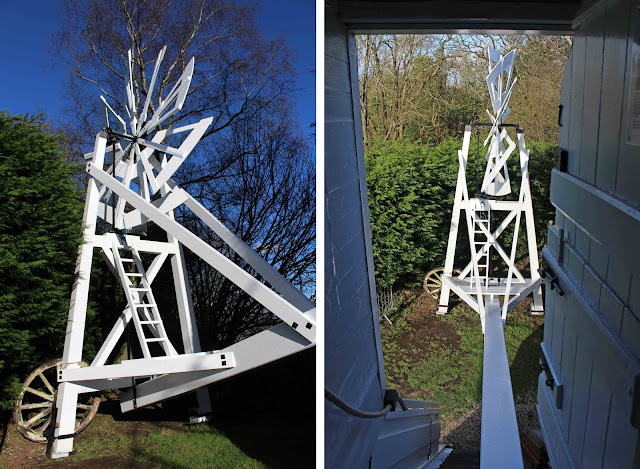I visited the Argos Hill windmill, near Mayfield
in northern East Sussex, on Sunday 12 March, its first open day of 2019, when
staying with my friend Jill, who's another windmill fan. This was the first windmill
open day I'd been too and, though this particular mill no longer functions, it
has been much restored so we were able to take a good look at its inner
workings on three separate levels.
The Argos Hill windmill, one of only 50 post
mills still extant in England, began its working life around 1835, with its two
pairs of milestones being used to produce both fine flour for human consumption
and a course meal for animal feed. A post mill, for those who are not familiar
with windmill terminology, is one where the entire body of the mill rotates on
its immensely strong central post to face into the prevailing wind.
During its working life, the Argos Hill
windmill passed through the hands of three separate milling families – the
Westons, Mr G. Wickens, and Mr Richardson of the Neve family – and continued
production right through until 1927, when all work ceased. The fantail blew off
in a gale in 1928, and the shutters were removed from the sails in 1932, after
which the mill sat abandoned until its first restoration began in 1955. Since
then, the mill has suffered damage by lightning and gales and the 1987
hurricane but, since the Friends of Argos Hill was set up in 1999, it has been
extensively conserved, preserved and maintained.
For the open day, much of the ground-level space
inside the mill building had been cleared to allow for a milling demonstration
using small quern stones and the energy of eager youngsters wanting to show off
their upper body strength. Wheat was poured into the top hole, the stone was
rotated (which obviously took some effort) and the crushed wheat spilled out
from the gap between the stones. For a finer result, the mixture was swept up
with a paintbrush, poured back in the top and the process repeated. I still
wouldn't have wanted to let the flour anywhere near my teeth though.
The ground level also had a few interesting
historical images and instructive signboards on display, and tea, coffee and
cake were being sold as a way to raise money for the ongoing restoration work.
Amazingly we didn't indulge!
Behind the mill structure was an intriguing
device that I had never seen at a windmill before – the fantail. The Friends of Argos Hill Mill's website explains
The fantail assembly is of traditional Sussex design. The fantail is fastened to the tailpole, which is independent of the steps. The fantail drives the two wooden cart wheels on the track around the mill, to keep the sails facing into the wind.
Even
if it had already been fully restored, the fantail could not function as it used
to as there is no longer sufficient space around the building. How amazing it
must once have been though.
Clambering up the steps by the fantail we
reached the spout floor and I was immediately struck by the intricacy and
ingenuity of the engineering, as well as the impressive craftsmanship that had
obviously gone into making and restoring everything. The spout floor, as you
might have guessed, houses the spouts down which the milled flour pours into
bins for bagging.
The next floor up, reached by a near vertical
ladder, was the stone floor where the grinding actually took place. I can
scarcely imagine the noise that must have made many a mill worker deaf when the
mill was in full swing. We didn't venture up to the very top level, the bin
floor, on to which the sacks of wheat were hoisted and emptied to begin the
milling process.
Keen volunteers were on hand at each level to
explain the mechanics of the windmill with true enthusiasm, and the windmill –
and their well-run open day – were a wonderful testament to their backbreaking
conservation efforts and their commitment to preserving such important parts of
England's early industrial heritage.










No comments:
Post a Comment